|
Current Issue - Spring/Summer 2013 Show Back Issues |
| ||
Want disease-free apples? Grow a ‘Liberty’!By Terrill Collier 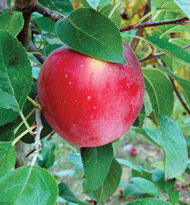 Grow your own mouth-watering apples with a disease-resistant ‘Liberty’.
Grow your own mouth-watering apples with a disease-resistant ‘Liberty’.
As I plan to add to my orchard this spring, I am no different than my clients in wanting low maintenance and disease free fruit. In Western Oregon and Washington we can grow amazing fruit. Just remember, our rainy climate is unlike the dryer fruit growing regions of Hood River and Washington State. Some of the familiar commercial apple varieties of Golden and Red Delicious, Fuji and Granny Smith do poorly here because of disease problems. By choosing wisely we can select disease resistant varieties that are low maintenance and taste delicious with full flavor that only a locally grown tree ripened fruit can provide. Our major apple and pear disease problems include:
Apple & Pear ScabA fungus which thrives in moist climates, causing damage
to leaves, shoots and fruits. The spores live on fallen leaves and diseased
leaves should be cleaned up and composted. MildewA fungus that prefers warm, humid (but not wet) conditions and causes significant damage to leaves and shoots in summer. It will also cause russeting (brown splotches) on fruit. 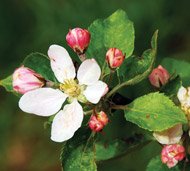 Bright blossoms and tasty fruit are yours for the having when you plant a
disease-resistant Liberty Apple Tree.
Bright blossoms and tasty fruit are yours for the having when you plant a
disease-resistant Liberty Apple Tree.
A ‘Liberty’ apple is a new, improved, disease resistant variety. I have grown this variety and can attest to its resistance to scab and mildew and to the full crispy flavor of this tasty fruit. If you have a small yard or want to easily pick fruit from the ground, grow this tree on a dwarf (M-26) rootstock. Liberty bears large, attractive, bright red, McIntosh-like fruit with sweet, slightly tart flavor, crisp and juicy flesh. Liberty is great for eating fresh, juice and baking. Liberty ripens in mid to late September and stores well for up to three months. Unlike many varieties that need a pollinator, Liberty is self pollinating. This easy care, heavy fruiting apple is highly recommended for home gardeners.
|
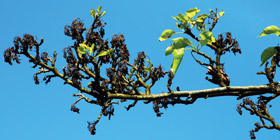
Scab disease on a flowering pear. Plant diseases infect during wet Spring weather, but preventative treatments need to be applied before and after the rains. Stop Destructive Plant Disease in its TracksOur ultra rainy Spring of 2010 will be remembered as the year of the blight
disease for the devastating effects on fruiting, flowering and ornamental trees
and shrubs. From Brown
Blossom Blight and shot hole diseases in the Cherries
and Plums, Anthracnose in the Maples, Sycamores and Dogwoods, and mildew everywhere
else, foliar diseases had a destructive impact on the health of our plants in
2010. Additionally, because of the water-logged soil conditions, many plants
died due to root rots such as Phytophthora, which kills many evergreen plants
such as cedars, juniper, photinia, and rhododendrons. Disease Prevention Steps
For information on specific diseases, refer to the Fact Sheets section of this site. 8 Dangerous Yard Activities That Can Maim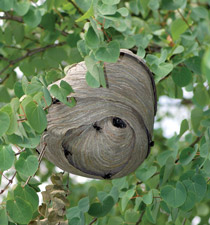 Hornet nests are well hidden in trees, shrubs or in the ground. Check plants and outdoor areas carefully to prevent attacks and stings. 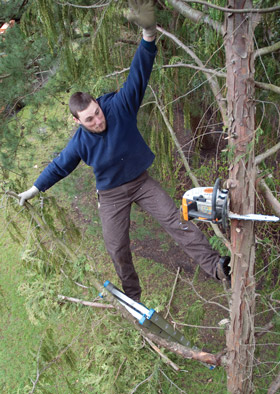 Always secure the bottom of the ladder on level ground and never go above the top step. Call Collier Arbor Care if your equipment isn’t up to the job. Gardening and yard work are some of the most popular leisure activities for Americans, but who knew about their dark side. Each year thousands of us are rushed to the emergency room or sadly the morgue, with yard work related injuries: cuts, falls, missing fingers — even freshly mowed feet. That Texas Chainsaw massacre could happen in your backyard this weekend. Many weekend warriors in the garden may not think to protect themselves from the dangers of yard work. When in doubt hire a professional arborist who has the safety training, the skills and the excellent safety record to tackle your backyard project. Collier employees have gone 1423 days without a time loss accident — an admirable achievement for our safety-minded 16 certified arborists performing tree, shrub and lawn services in your landscape. 1 —You Fall off a LadderAbout 136,000 people get a fast ambulance ride each year to the emergency room because of ladder related accidents. Secure the bottom of the ladder on level ground to prevent slippage.2 — Chainsaw MassacreThere are more than 40,000 chainsaw injuries per year. The average chainsaw injury requires 110 stitches and cost an average of $12,000. Thirty-six percent of the injuries occur to the legs, knees and feet, so wear boots and chainsaw chaps for protection. Other required safety gear includes hard hat, eye and ear protection, gloves and chainsaw with anti-kickback devices.3 —Electrocution from Planting TreesBefore you decide to decorate your yard by planting that new tree or putting in a fence make sure you “Call before you dig”. Protect yourself from hidden underground utilities like electrical, gas, and water before digging in your yard. In Oregon call the number: 1-800-332-2344 before you dig to locate and discover hidden utilities.4 — Mowing the Toes Instead of the GrassMind the bare toes and the flying debris when lawn mowing. Some 80,000 Americans go to the hospital because of accidents involving lawn mowers. The majority of victims are children and the elderly.Wear safety glasses and closed toed shoes. Keep kids and pets away from mowing operations and never hold your kids in your lap while using a riding lawn mower. 5 — Losing a Finger While Trimming the BushesMind your fingers when trimming hedges. U.S. Consumer Product Safety Commission reports that hospital emergency rooms treat more than 400,000 outdoor garden-tool-related accidents each year. Wear gloves and keep hands and fingers away from power shears, saws and pruners. Wear eye protection too.6 — Insect AlertSpiders and bees and ticks — OH MY! Many people visit the emergency room due to wasp stings, and spider bites. Ticks can transmit diseases like Rocky Mountain spotted fever and Lyme disease. Watch out for yellow jacket nests in the summer, especially if you are allergic to stings.7 — Deadly Garden PlantsYour favorite garden plant could send you, your children, or your pets to the emergency room if ingested. Beware of popular ornamentals like rhododendron, kalmia, lily of the valley, daffodils and foxglove, to name a few. Also beware of poison oak (leaves of three let it be) that can cause a severe rash and itching when encountered.8 — Garden Chemical DangersGarden chemicals are a common cause of accidental poisoning in children. Store concentrated chemicals in locked areas to prevent accidental poisoning.Some garden chemicals, especially some of the old ones, can be toxic when miss-applied or over used. Dispose of all chemicals properly at designated recycling stations. Collier Arbor Care has organic tree, shrub, lawn and fruit tree programs that are gentle for people, pets and the environment, but tough on pests and diseases. There’s no need to risk injury or illness to enjoy a beautiful landscape. Collier Arbor Care is here to offer assistance and advice in keeping your landscape looking great. Always feel free to call or send an email to discuss any of your landscape concerns. Top 10 Disease Resistant TreesPaperbark
Maple (Acer griseum) 20-30’ — Exfoliating orange bark for
winter interest. Leaves are divided into three leaflets, green with silvery
underside, bright red fall color, Full sun or shade, slow growing specimen tree. |
|
Home |
Services |
The Arbor Advisor |
Garden Calendar |
About Us |
Fact Sheets |
Contact Us |
Site Map Collier Arbor Care Portland 503-722-7267 Vancouver (360) 693-6056 Site contents and design ©2013 Collier Arbor Care |
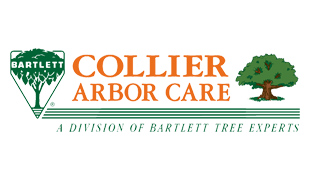






 top »
top »